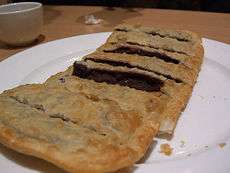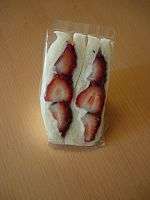Sweet bean paste
| Sweet bean paste | |||||||||||
|
A pancake using dou sha ingredient | |||||||||||
| Chinese | 豆沙 | ||||||||||
|---|---|---|---|---|---|---|---|---|---|---|---|
| Hanyu Pinyin | dòu shā | ||||||||||
| Literal meaning | bean sand | ||||||||||
| |||||||||||
Sweet bean paste is a food ingredient used in several Asian cuisines. Within Chinese cuisine, it is primarily used as a filling for sweet desserts and Chinese pastry.
Production
The beans are usually boiled without sugar, mashed, and diluted into a slurry. The slurry is then strained through a sieve to remove the husks. The resulting liquid is then filtered and squeezed dry using cheesecloth, and then finally sweetened. Oil in the form of either vegetable oil or lard is usually added to the relatively dry paste to improve its texture and mouthfeel.
Oiled sweet bean paste is mainly found as fillings for Chinese pastries, while un-oiled sweet bean pastes can be used to make tong sui. Japanese pastries use primarily un-oiled sweet bean pastes.
Types
There are several types of sweet bean paste:
- Oil bean paste (油豆沙) - made from azuki beans; dark brown or black in colour from the addition of sugar and animal fat or vegetable oil, and further cooking; sometimes also includes Sweet Osmanthus flavor
- Mung bean paste (綠豆沙) - made from mung beans and dull reddish purple in colourphoto
- Red bean paste (紅豆沙) - made from azuki beans and dark red in colourphoto
- White bean paste (白豆沙) - made from navy beans and greyish off-white in colourphoto
- Black bean potato paste (黑豆沙) - made from black soybean powder (黑豆面) and potatoes; used in Beijing cuisine and other cuisines of northern Chinaphoto
Others
There are a number of other pastes used in Chinese cuisine, primarily as fillings for dessert items. Although not made from beans, they share similar usage and are equally popular. They are very similar in flavor and texture to sweet bean paste. These include:
- Lotus seed paste
- Black sesame paste
See also
References
- Hsiung, Deh-Ta (2000). The Chinese Kitchen: A Book of Essential Ingredients with Over 200 Easy and Authentic Recipes. Foreword by Ken Hom. St. Martin's Press. ISBN 0-312-24699-4. ISBN 978-0-312-24699-0.

